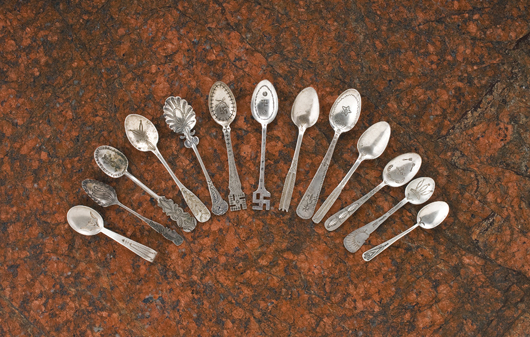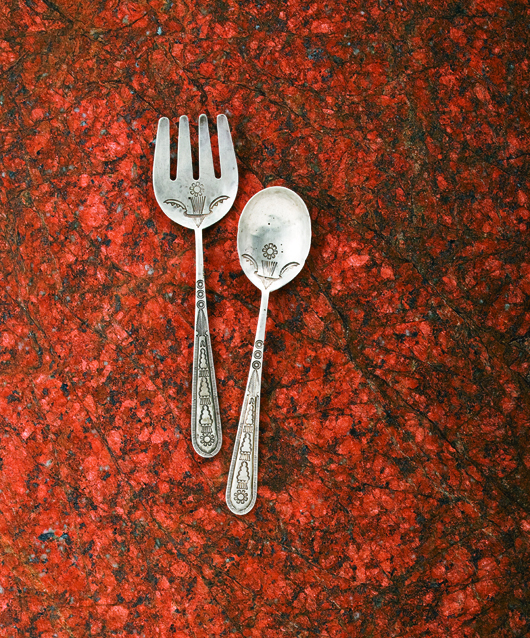
Objects with these trader-influenced motifs were lighter in weight and less expensive than traditional Indian jewelry, hence they held great appeal for tourists traveling in the Southwest. Herman Schweizer, manager for the Fred Harvey Indian department known for his taste and business acumen, said that pawn jewelry (traditional old Southwestern jewelry) was “too heavy for tourist taste” (Batkin 2008:113).
Curio trade items expressed the exotic charm of the Southwest. Initially, as early as 1903, they were made and sold by Indian silversmiths in a backroom at Harvey’s Alvardo Hotel in Albuquerque, N.M. (115). A history of these items demonstrates that many objects were made and sold in shops all over the Southwest. Despite the difficulty of authenticating a genuine Harvey Co. object from one purchased or made elsewhere, these Southwestern antiques have become highly desirable collectors’ items. Therefore, peeking into the manufacturing history of trade curios reveals some fascinating information.
From about 1910 to 1940 some of these trade items were completely handmade while others were made with the assistance of impressively specialized machines. Handmade jewelry meant that the smith used traditional Indian techniques-hand-cutting pieces from a hand-hammered block of silver or a Mexican peso, then laboriously filing, stamping and polishing each object. Machines shortened the endeavor by creating commercial sheet silver and machine drawn wire. A pair of handmade earrings, for example, would sell for about $4, whereas machine-made earrings could be made at the rate of 30 per minute and “purchased wholesale for $6 per dozen” (152). Thus, widespread confusion and distrust existed among consumers. Which objects were really Indian handmade versus those only Indian-designed and made mostly by machine? To make matters worse, some objects were not made or designed by Indians at all.
The Fred Harvey Alvarado Hotel in Albuquerque, the region’s best-known retailer sold thousands of these popular curio trade objects. While Indian silversmiths made many of the items sold at the Alvarado, similar pieces could be purchased across the street at the H.H. Tammen Co. or from other traders (187). Silversmiths working in the backrooms of Tammen used machines for a wide range of jewelry-making activities. One mechanized press was capable of stamping out one hemisphere of a half- inch silver bead (133).
Naturally, this makes it nearly impossible to determine genuine handmade Fred Harvey bracelets and objects from those made elsewhere or by machine. In fact a close examination of stamping dies from two different companies reveals that the designs are virtually indistinguishable (170-171). The dubious origins of Fred Harvey jewelry, combined with the fact that ideas and patterns were often flat out stolen, only makes the identification process and attribution to the Harvey Co. even more complicated (154).
The controversy of handmade versus machine-made led two Indian silver experts, John Adair and Kenneth Chapman, to study the issue. They focused on the “physical character of worked silver,” which was at the heart of the heated controversy. Chapman invented a tool capable of detecting “irregularities in the thickness of a bracelet.” Thus he believed it possible to determine whether the bracelet had been hand-wrought or made from commercial sheet silver (207). But Adair, author of an in-depth study on Southwestern Indian jewelry, maintained that all pieces of “well-finished jewelry looked similar” (207). Hence the process of deciding which curio bracelets are machine-made, which are handmade, and then, which are authentic Fred Harvey bracelets still remains an elusive goal.
Regardless, this type of jewelry is attractive and timeless. The Native American Curio Trade in New Mexico (Santa Fe, N.M.: 2008) by Jonathan Batkin fully discusses the history of curio jewelry and is a good reference to have if collecting. Prices will vary, so when buying curio jewelry, buy what you love and what you find attractive.
Research by Susan Labry Meyn.
Wes Cowan is founder and owner of Cowan’s Auctions, Inc. in Cincinnati, Ohio. An internationally recognized expert in historic Americana, Wes stars in the PBS television series History Detectives and is a featured appraiser on Antiques Roadshow. Wes holds a B.A. and M.A. in anthropology from the University of Kentucky, and a Ph.D. in anthropology from the University of Michigan. He is a frequently requested speaker at antiques events around the country. He can be reached via email at info@cowans.com.
ADDITIONAL IMAGES OF NOTE





